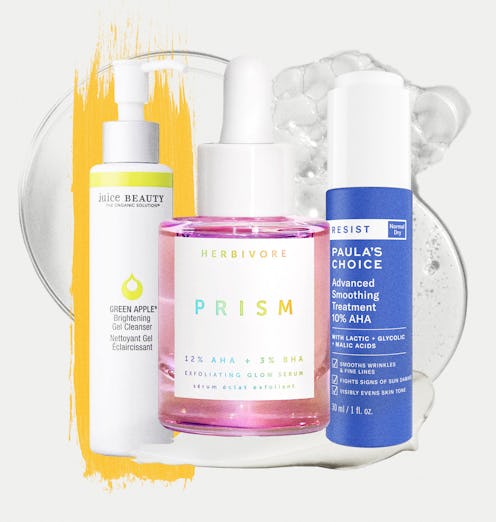(Back To Basics)
If You Have Sensitive Skin, Malic Acid Is Going To Be Your New Favorite Exfoliant
Get a brighter complexion sans irritation.

With new products, brands, and categories popping up every day, beauty can be a bit overwhelming. Back to Basics is our rudimentary beauty series that serves as your crash course on the science behind some of the best formulations in the game. This week, we’re taking a look at malic acid for your skin.
Ah, exfoliation. A skin care step that’s deemed essential but is still shrouded in confusion and controversy. How often should you exfoliate? Is chemical or physical exfoliation better? The answers to these common questions about the process of removing dead skin cells off your face will vary depending on your skin type. Those who have sworn off manual exfoliants like face scrubs because they’re too abrasive are probably familiar with chemical exfoliants like AHAs and BHAs. However, high concentrations and improper application of these ingredients can also be irritating. That’s where malic acid comes in. The gentle yet effective chemical exfoliant lifts dead cells to help reveal clearer, brighter skin without any redness or tenderness.
If malic acid sounds familiar, it’s probably because the exfoliant keeps showing up in more and more skin care products’ inkey lists. Along with being mild enough for the sensitive skin, the acid also complements other chemical exfoliants when they’re combined in a single formula. Ahead, TZR tapped two dermatologists to break down the basics on malic acid, including what it is, how to use it, and the best products to add to your skin care routine.
What Is Malic Acid & What Are Its Skin Care Benefits?
Malic acid is an alpha hydroxy acid (AHA) that’s commonly found in wine and fruits like apples and cherries. Dr. Melanie Palm, MD, board-certified dermatologist and cosmetic surgeon at Art of Skin MD, says that when used in skin care, malic acid can help remove dead skin cells from the outermost layer of the skin and unclog pores for a brighter, smoother, more even-toned complexion.
In addition to treating uneven texture, fine lines, wrinkles, and hyperpigmentation, malic acid is also hydrating. “Malic acid is also considered a humectant, which can improve your skin’s ability to stay hydrated,” Dr. Palm shares.
Whenever you use a chemical exfoliant like malic acid, it resurfaces the skin, which reveals the glowier healthy layer underneath. In turn, Dr. Kim Nichols, board-certified dermatologist and founder of Nichols MD, adds that the ingredient, along with other AHAs, can “also increase the thickness of deeper layers in the skin to restore firmness.”
Who Should Use Malic Acid?
Because malic acid has a larger molecular size than other AHAs, it penetrates the skin more slowly. Dr. Nichols says this makes it a gentler option. While nearly anyone can benefit from including the AHA in their skin care routine, she often recommends it to those with mature skin or darker complexions because of its firming and brightening benefits.
While there is limited data on whether malic acid is pregnancy safe, Dr. Palm says that because most other AHAs are considered unsafe for those who are pregnant or breastfeeding, it’s best to avoid using it while pregnant or breastfeeding.
What Are The Side Effects Of Malic Acid?
While malic acid is generally safe to use because it’s less irritating than other AHAs, Dr. Palm recommends doing a patch test before fully integrating it into your skin care routine. “Like with other AHAs, it’s possible that malic acid can cause irritation or inflammation in certain individuals — this is why it’s important to patch test a new skin carep active before applying it all over your face or body,” she confirms.
Additionally, malic acid can make your skin more sensitive to sun exposure, so it’s important to properly apply sunscreen if you’re using products formulated with it, along with any other AHA.
How To Incorporate Malic Acid Into Your Skin Care Routine
Malic acid is best used like other exfoliants: on dry, cleansed skin before any hydrating serums and moisturizers. It can be used several times a week, but err on the side of caution and start off once or twice a week to ensure your skin can tolerate it. Because malic acid is a humectant, Dr. Palm suggests using it right before a hyaluronic acid serum to draw in extra moisture to the skin.
Both dermatologists point out that layering malic acid with other AHAs, BHAs, vitamin C, or retinoids can be irritating to the skin unless these ingredients appear in the same product. “There’s a lot of back and forth in skin care about avoiding mixing alpha hydroxy acids such as malic acid with vitamin C and retinoids, but companies are creating formulas that allow these active ingredients to work synergistically, leaving you with a stronger result.
Even though chemical exfoliants are typically recommended to be used at night while skin is in repair mode, as previously mentioned, they do make the skin more susceptible to sun damage. So be sure to apply a sunscreen that’s SPF 30 or higher to prevent burns.
Shop Malic Acid Skin Care Products
This article was originally published on